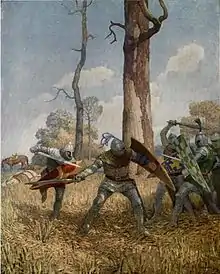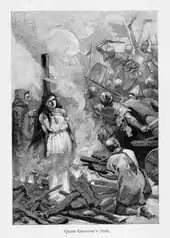Gaheris
Gaheris /ɡəˈhɛrɪs/ or Gaheries (Old French: Gaherie[t/z], Gah[a/e]eriés[note 1]) is a character in the Arthurian legend, a nephew of King Arthur and a knight of the Round Table, the third son of Arthur's sister or half-sister Morgause and her husband Lot, King of Orkney and Lothian. He is the younger brother of Gawain and Agravain, and the older brother of Gareth and half-brother of Mordred.[note 2] In Thomas Malory's popular Le Morte d'Arthur, Gaheris is little more than a supporting character to Gawain and Gareth, with the murder of Morgause an odd exception, but his role is greater in the French prose cycles. Later, he and Gareth are both killed by Lancelot during his rescue of Guinevere. A different knight known as Gaheris of Karaheu also appears in the legend.
| Gaheris | |
|---|---|
| Matter of Britain character | |
 Gaheriet's attributed arms | |
| First appearance | Perceval, the Story of the Grail |
| Created by | Possibly Chrétien de Troyes |
| Based on | Gwalhafed |
| In-universe information | |
| Title | Prince, Sir |
| Occupation | Knight of the Round Table |
| Family | Lot, Morgause, Agravain, Gawain, Gareth, Mordred, King Arthur's family |
| Spouse | Lynette |
Origin
It is likely that Gaheris and Gareth were actually the same character in origin, as their names in French sources are easy to confuse Guerrehet (Gareth) and Gaheriet (Gaheris), and adventures ascribed to the brothers are often interchangeable. Furthermore, only one brother is ever named for Gwalchmai ap Gwyar, the character from Welsh mythology traditionally identified with Gawain. This character (Gwalchafed, Gwalhafed, Gwalhavet, Old Welsh for "Hawk of Summer") is a likely source for Gaheris and Gareth, if Gawain was indeed derived from Gwalchmai.[3]
Medieval literature
Several of his adventures are narrated in the Lancelot-Grail (Vulgate Cycle). In the Prose Lancelot, Gaheris (Gaheriet) is described as valiant, agile, and handsome (even as "his right arm was longer than the left"[4]), but reticent in speech and prone to excess when angered. As such, he "was the least well spoken of all his peers." In the Vulgate Merlin, he is described as the best warrior among the brothers, and the Prose Tristan notes him as a far better knight than Gawain but nevertheless all the siblings are knighted at once.
He is, however, the first of the Orkney clan to be knighted by King Arthur in the Post-Vulgate Cycle. When Gaheris is given flowers sent by the Queen of the Fairy Isle, it is prophesied that he would surpass in goodness and valor all the Knights of the Round Table save for two (presumably Galahad and Lancelot) were it not for the death of his mother which Gaheris will cause through his sin. The young knight sets out in quest of Gawain and Morholt, during which he is twice attacked by his envious brother Agravain but soundly defeats him on each occasion, and eventually rescues both Gawain and Morholt, later accompanying the latter to Ireland. In Thomas Malory's Le Morte d'Arthur, based on the Post-Vulgate, Gaheris is at first a squire to his elder brother Gawain, whose fiery temper he helps moderate, before being knighted himself. Gaheris later marries the sister of his brother Gareth's wife Lyonors, the haughty damsel Lynette. The Lancelot and the Mort Artu (Death of Arthur) sections of the Lancelot-Grail cycle differ in their characterisation of Gaheris. In the Lancelot, his younger brother Gareth is Gawain's most cherished brother. In the Mort Artu, Gaheris is represented as the most cherished, and his death anguishes Gawain profoundly.[5]

In the Post-Vulgate tradition, Gaheris participates in the revenge killing of King Pellinore, the slayer of his father King Lot. More notorious is his beheading of his own mother Morgause after catching her in flagrante delicto with Lamorak, Pellinore's handsome son and one of the greatest knights of Arthur. Lamorak meanwhile escapes, but is later hunted down by all of the Orkney brothers except Gareth, believing him to be their mother's murderer, and they fight him until Mordred stabs him in the back; the act that is deemed cowardly and a blot on their honour. When Arthur discovers that Gaheris is Morgause's killer, he is banished from court. Gaheris is then himself nearly beheaded in revenge for their mother's death by Mordred and Agravain when Gareth convinces Gawain to order them to stop. Despite being exiled, Gaheris appears later in the narrative as a one-time companion of Percival on the Grail Quest. He is also a friend of Tristan in the Prose Tristan. Its Belarusian version Povest' o Tryschane features him as Arthur's son rather than his nephew, by the name Garnet.

His death during Lancelot's rescue of Queen Guinevere from being burned at the stake is related in the Mort Artu, the final volume of the Vulgate and Post-Vulgate prose cycles.[6] While Gawain and Gareth will have nothing to do with Agravain and Mordred's plot to entrap Lancelot and Guinevere (in the English Stanzaic Morte Arthur, Gaheris also sides with them), Arthur asks the all brothers of Mordred to help guard the queen's execution. Gaheris and Gareth reluctantly agree, though Gawain refuses. When Lancelot rushes to save the woman whom he loves, he cuts down the Orkney princes; in the Vulgate Mort Artu, Gaheris' helmet is first knocked off by Hector de Maris and then his head is split by Lancelot himself. The surviving brother Gawain's fury is terrible and the resulting feud leads to the destruction of Arthur's kingdom.
In the Post-Vulgate version of the Mort Artu, a knight from North Wales confusingly also named Gaheris takes the vacant Round Table seat that had belonged to Gaheris of Orkney after the death of the latter. That "new" Gaheris participates in the following civil war on Arthur's side.
Modern stories
- T. H. White's The Once and Future King attributes the act of matricide to Agravaine instead of Gaheris. White gives his own individual interpretation to the story, depicting Agravaine as having an unhealthy love/lust obsession for his own mother, and repeatedly describes Gaheris as "dull" or "dull-witted".
- In the film First Knight (1995), Gaheris is portrayed by Alexis Denisof. He participates at the final battle for Camelot and survives against Malagant and his army.
- In Gerald Morris' The Squire's Tales, Gaheris is one of the main heroes, a witty, quietly brave man who prefers agriculture to sword fighting.
Notes
- Spelling varies according to sources and declension. In the Old French La Mort le roi Artu: "Gaheriet" in the oblique case, "Gaheriez" in the nominative case.[1]
- An enumeration of the four brothers (excluding Mordred) can be found in Chrétien de Troyes's Perceval, the Story of the Grail when Gawain tells the "white-haired queen" (his grandmother Igraine) the names of the four brothers ("Gawain is the oldest, the second Agravain the Proud [...], Gaheriet and Guerehet are the names of the following two." (verses 8139–8142 in the Dufournet edition; verses 8056–8060 in the Méla edition). A portrait of the five brothers (including Mordred) can be found in the prose Lancelot.[2]
References
- Jean Frappier, ed., La Mort le roi Artu, Paris: Droz, 1996, p.291. ISBN 2600001832).
- Norris J. Lacy, ed., Lancelot-Grail: Lancelot Parts III and IV, Volume 4 of Lancelot-Grail: The Old French Arthurian Vulgate and Post-Vulgate in Translation, Boydell & Brewer Ltd, 2010, pp. 392–4. ISBN 9781843842354.
- "Britannia EBK Biographies: Sir Gwalchafed, Prince of Gododdin". britannia.com. Archived from the original on 22 September 2012. Retrieved 5 December 2018.
- Lacy, Norris J. (2010). Lancelot-Grail: Lancelot, pt. III. Boydell & Brewer Ltd.
- Norris J. Lacy, ed., Lancelot-Grail: Lancelot Parts III and IV, pp. 393–4.
- Norris J. Lacy, ed. and trans., Lancelot-Grail: The Death of Arthur, Volume 7 of Lancelot-Grail: The Old French Arthurian Vulgate and Post-Vulgate in Translation, Boydell & Brewer Ltd, 2010, p. 69-70. ISBN 9780859917704.
External links
- Gaheris at The Camelot Project